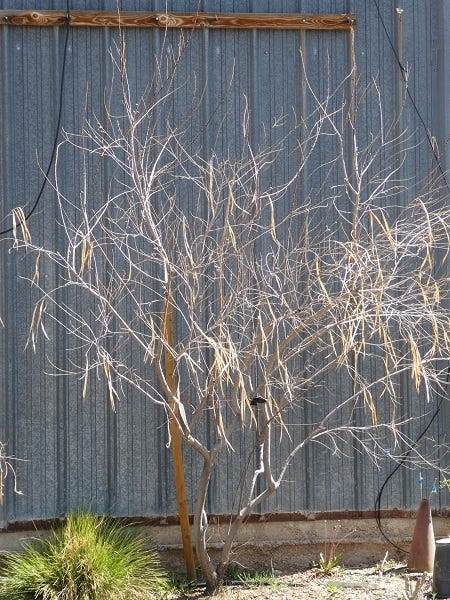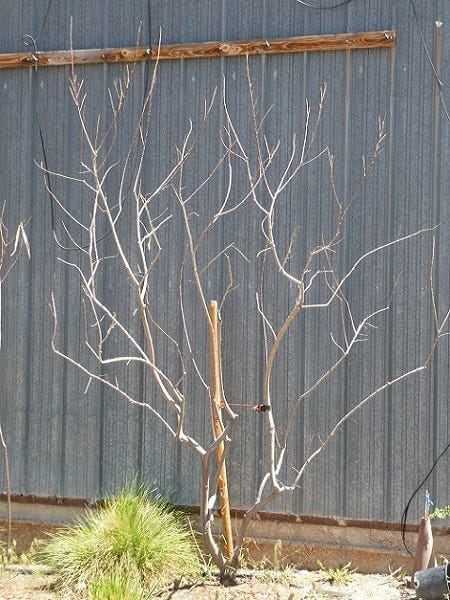By David Salman, High Country Gardens Founder and Chief Horticulturist
Every gardener counts down the days until they can get into the garden for spring. Here are some spring clean-up tips to help make your garden and landscape more habitat-friendly and prepare your garden for the upcoming growing season.
Perennials
Come mid-spring, it's time to cut back our perennials.
Herbaceous, also called "deciduous", are perennials that have dead, above-ground stems and leaves. In general, these perennials will show you where to cut, such as our photo example of our Agastache. Look for a mound of new foliage at the base of the old stems and remove these dead brown stems.
-
Evergreen perennials like Lavender, Rosemary, Rock Rose (Helianthemum), Beardtongue (Penstemon) and others, only need to have winter killed stem tips and leaves removed.
Don't cut back evergreens to ground-level like their herbaceous neighbors.
-
Lavender (Lavandula): To get these important ornamental herbs ready for the new growing season, I recommend waiting to cut them back until you can see tiny green stems beginning to push out from the old woody stems. This will show you how much of the old branches have been damaged by winter cold and desiccation.
Shear the plants to remove the dead branches just above where the new growth is emerging from the old stems, to leave a nice rounded mound of stems and foliage. Remove old dead foliage in the plant's interior by roughing them up the stems/leaves with gloved hands.
Beardtongue(Penstemon): Cut back the old flowering stems and lanky stems to leave a nice mound, rounded mound of the evergreen leaves and stems. This will re-invigorate the plants and make the flowering stems more even.
Other Evergreen Perennials: Simply remove winter killed stem tips and foliage to leave a nice mounded plant.
Deciduous Shrubs and Trees
As a general rule, prune before leaf and flower buds begin to swell. In the Southwest, the time for hard pruning of shade, fruit, flowering trees, and spring-blooming shrubs usually ends at the end of February. In colder northern climates, the pruning season can extend to the end of March.
Desert Willow (Chilopsis):This small to medium sized tree (depending on the variety) blooms in early summer on the new season's growth. I like to give my desert willows a good pruning in mid-spring before they leaf out.
Remove crossed branches and small to medium twigs growing on the inside along the main stems. Cut off dead tips damaged by winter. Remove up to a quarter to a third of the smaller branches to leave room for vigorous summer growth.
Summer-Blooming Shrubs
Russian Sage (Perovskia), Blue Mist Spirea (Caryopteris) and Butterfly Bush (Buddleia davidii and hybrids) can be cut back in mid-spring.
Russian Sage should be cut back hard in mid-spring, leaving stems 12-15" tall. This should be done every spring to keep them blooming heavily. This is also the time to dig "suckers" (new stems to push up from the ground) so to keep your Russian sage in bounds and not overtaking its neighbors.
Blue Mist Spirea and Buddleia davidii should be cut back by 1/3 to 1/2 of their height every third year (NOT annually) to re-invigorate the shrubs and encourage blooming.
Spring blooming Buddleia alternifolia should NOT BE CUT BACK in spring as it blooms on last year's growth (like fruit trees and other spring-blooming shrubs). Instead, wait until blooming is done and remove the flower spikes back to where you see the new branches beginning to push out. Cut out any crossed branches and small diameter branches in the interior of the plant.
Ornamental Grasses
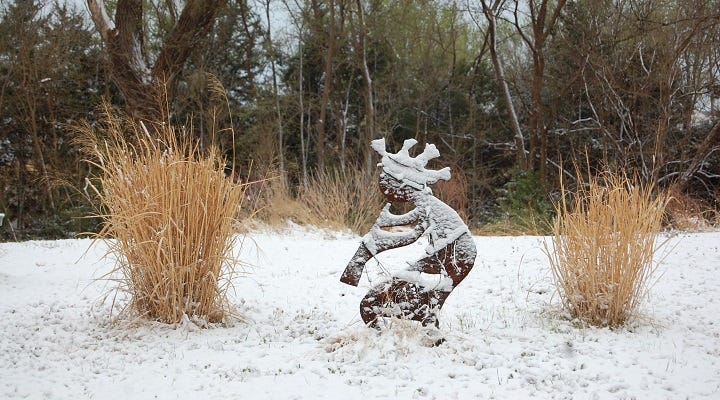
Now that they are looking shop worn and past their winter prime, mid-spring marks the time to cut them back. Also it may be time to re-invigorate older clumps by dividing them.
There are two categories of grasses; cool season and warm season growers. They are handled differently during spring clean-up.
-
Warm season grasses include Little Bluestem (Schizachyrium), Big Bluestem (Andropogon), 'Blonde Ambition' Blue Grama (Bouteloua), Muhly (Muhlenbergia), Prairie Switchgrass (Panicum), Chinese Maidenhair Grass (Miscanthus), Giant Sacatoon (Sporobolus wrightii) and others.
They should be cut back in mid-spring. Leave about 2 to 4 inches of stubble standing; big growers should be left with about 4" and smaller growers should be left with about 2".
-
Cool season grasses like Blue Avena Grass (Helictotrichon), Fescue grass (Festuca), Silky thread Grass (Nassella) and 'Karl Foerster' Feather Reed grass (Calamagrostis) have evergreen foliage that should not be cut to the ground. Instead vigorously "comb out" dead leaves with gloved hands and clip off the dead leaf tips.
In early to mid-spring, clip off old seed head stalks as far down into the foliage as possible to leave room for late spring flowers.
Dividing Older Grass Clumps
If the grass plant has a ring of living leaves with a dead center, it's time to divide the grasses to re-invigorate them.
Dividing is only necessary once every three to five years depending on the species and growing conditions. Get a strong shovel and dig up the grass clump. Then, with your shovel cut the clump into quarters and remove the dead stems from the center, leaving only healthy stems and roots.
Work some compost and Yum Yum Mix into the hole and replant one or two pieces back into the same hole. You now have at least two or three other pieces to transplant elsewhere or give to friends.
Wildflower Meadows

Mowing: Mid-spring is the time to mow your wildflower meadow. Cut it back to about 4 inches in height. It's essential to mow your meadow to reduce weed competition and help the soil to warm up by exposing it to the sun's rays.
-
Weeding: Early to mid-spring is a good time to good out into your meadow and pull common weeds. It's not like warm season grass lawns where the grass is dormant and the weeds are green.
Many wildflowers are cool season growers and green-up earlier than the native warm season grasses. So learn to identify common weeds (bindweed, mallow, wild lettuce, thistle) and remove them early before they grow and set seed.
Grass Meadows and Native Grass Lawns
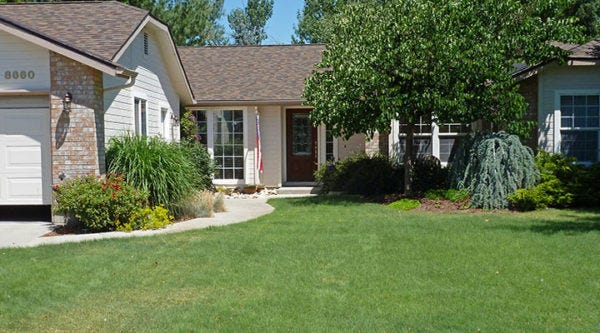
Native Warm Season Grass lawns (Buffalo and Blue Grama Grass)
These native grasses are late to "green up" and won't emerge from winter with green foliage like traditional cool season grass lawns like Kentucky Bluegrass and Fescue grass lawns.
-
Weeding: When your native grass lawn is still dormant (brown), this is the ideal time to do your spring weeding to reduce weed competition and keep your native grass lawn looking well manicured.
Any green grass and other weeds are easy to see and should be pulled. Get your weed fork and go to it.
For large areas where hand weeding might not be practical, on a sunny day you can spot spray the individual weeds with squirt of horticultural strength vinegar, or an oil type natural contact herbicide. (You can mix your own weed killer: 1 liter of vinegar, 1 teaspoon of natural liquid soap--helps the vinegar stick to the plants--and 5 drops of an herbicidal oil such as citrus, clove, thyme or cinnamon oil.) Be careful to only apply to the weeds. You many need to reapply. Weeds with long tap roots are best removed by hand.
Mowing: Wait to mow your native grass lawn until it "greens up" and becomes more than 4 to 6 inches tall. Then cut back to 4" in height (never scalp it!).
This is also a warm season grass, but is not native.
-
Weeding: By the third year after planting, Dog Tuff becomes essentially weed-proof and chokes out most common weeds. But with younger lawns, the same strategy applies as above; find and pull anything green. It's a weed.
Mowing: Wait to mow your native grass lawn until it "greens up" and becomes more than 4 to 6 inches tall. Then cut back to 4" in height (never scalp it!).
Edging: Mid-spring, when the foliage is still dormant, is a good time to dig up the edges if Dog Tuff is spreading into flower beds.
Spring Blooming Bulbs
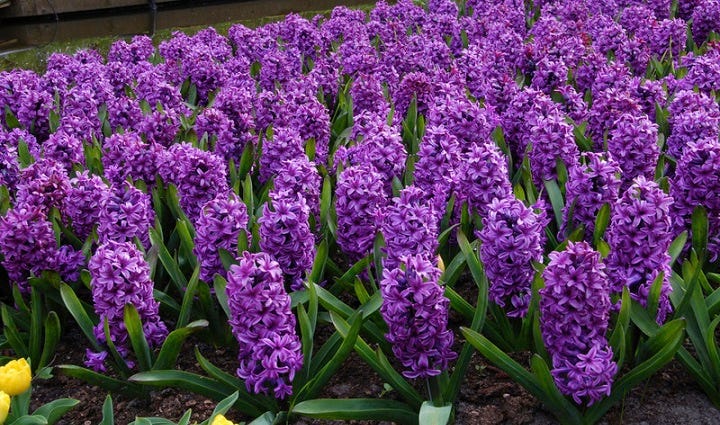
Resist the temptation to cut back your spring blooming bulbs after the flowers are finished. Bulbs need their green leaves to photosynthesize and feed the below-ground bulb after flowering is done.
Instead, leave your spring blooming bulb foliage alone until it begins to turn yellow/brown. Then the leaves can be cut off at ground level.
I recommend planting your perennial bulbs in with other flowering perennials. That way, as the bulbs go dormant and their foliage begins to look yellow and tattered, the green foliage of your actively growing perennials will help to camouflage them.
If your perennial bulbs don't bloom well and seem really crowded, make a note-to-self to divide them this coming fall.
Take some photos of where they are, so you can go back in late October/early November (during bulb planting season) to lift the old bulbs and re-plant them by enriching the soil and spacing them out to give them room to naturalize.




